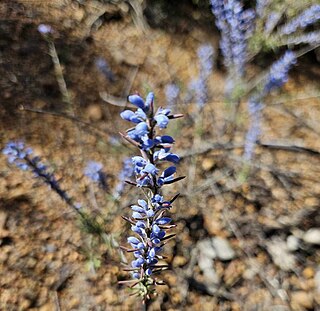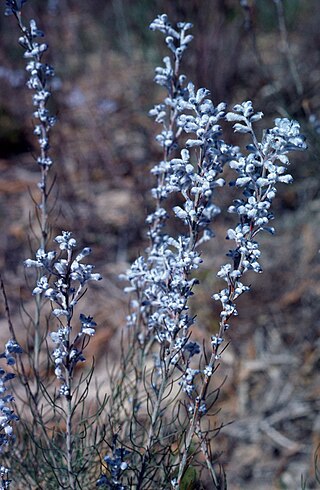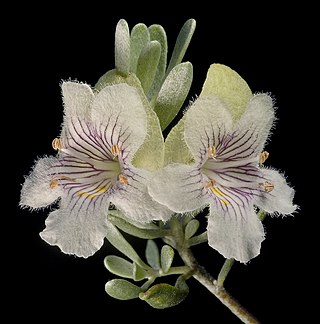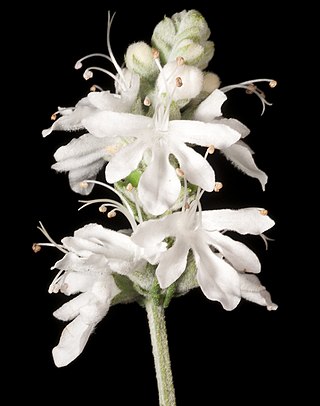
Conospermum is a genus of about 50 species of flowering plants in the family Proteaceae that are endemic to Australia. Members of the genus are known as smokebushes - from a distance, their wispy heads of blue or grey flowers resemble puffs of smoke. They have an unusual pollination method that sometimes leads to the death of visiting insects. They are found in all Australian states, though most occur only in Western Australia. Smokebushes are rarely cultivated, though the flowers of several Western Australian species are harvested for the cut flower industry.

Conospermum acerosum, commonly known as needle-leaved smokebush, is a species of flowering plant in family Proteaceae and is endemic to the south west of Western Australia. It is spindly, erect or straggly shrub with needle-shaped or thread-like leaves, panicles of white or pink flowers and reddish brown nuts.

Cryptocarya erythroxylon commonly known as rose maple, rose walnut, pigeonberry ash, red-wooded cryptocarya, southern maple or bottleberry, is a species of flowering plant in the laurel family and is endemic to eastern Australia. Its leaves are elliptic to lance-shaped the flowers cream-coloured and tube-shaped, and the fruit a pear-shaped black drupe.

Conospermum taxifolium, commonly known as variable smoke-bush, yew-leaf smoke bush or paint brush, is a plant in the family Proteaceae and is endemic to eastern Australia. It is an erect shrub with narrow elliptic to narrow egg-shaped leaves with the narrower end towards the base and panicles of cream-coloured to white, tube-shaped flowers.

Styphelia adscendens, commonly known as golden heath, is a species of flowering plant in the heath family Ericaceae and is endemic to south-eastern Australia. It is a prostrate or low-lying shrub with lance-shaped leaves and cream-coloured, pale yellowish-green or reddish flowers arranged singly or in paris in leaf axils.

Cassinia tenuifolia, commonly known as bully bush or killmoke, is a species of flowering plant in the family Asteraceae and is endemic to Lord Howe Island. It is a dense, bushy shrub with hairy young stems, crowded linear leaves and sweetly scented flower heads arranged in corymbs.
Cassinia monticola commonly known as mountain cassinia, is a species of flowering plant in the family Asteraceae and is endemic to mountain areas of south-eastern Australia. It is a spreading shrub with sticky, narrow linear to narrow lance-shaped leaves, and bronze-coloured to greenish-cream heads of flowers arranged in a dense, round-topped corymb.

Calytrix achaeta, commonly known as the white-flowered turkey bush, kerosene wood or fringe-myrtle, is a species of flowering plant in the myrtle family Myrtaceae and is endemic to north-western Australia. It is a shrub or tree with hairy branchlets, egg-shaped, linear or lance-shaped leaves, and white to cream-coloured flowers with 12 to 18 stamens in a single row.

Conospermum amoenum, commonly known as blue smokebush, is a species of flowering plant in the family Proteaceae and is endemic to the south-west of Western Australia. It is an erect or spreading shrub with linear leaves, and spikes of blue or white tube-shaped flowers.

Conospermum boreale is a species of flowering plant in the family Proteaceae and is endemic to the south-west of Western Australia. It is an erect, much-branched shrub with egg-shaped to elliptic or lance-shaped leaves, and panicles of woolly, white flowers.

Conospermum brachyphyllum is a species of flowering plant in the family Proteaceae and is endemic to the south-west of Western Australia. It is an open shrub thread-like leaves, and panicles of woolly, white flowers.

Conospermum bracteosum is a species of flowering plant in the family Proteaceae and is endemic to the south-west of Western Australia. It is an erect, spindly shrub with egg-shaped leaves, sometimes with the narrower end towards the base, and spikes of silky, woolly, tube-shaped white flowers.

Prostanthera althoferi is a species of flowering plant in the family Lamiaceae and is endemic to inland areas of Australia. It is an erect shrub with its stems and leaves densely covered with silvery, greyish-green hairs, and has narrow egg-shaped leaves and white to cream-coloured flowers with mauve or purple striations inside.

Prostanthera canaliculata is a species of flowering plant in the family Lamiaceae and is endemic to the south-west of Western Australia. It is a small, erect shrub with hairy branchlets, narrow egg-shaped to narrow elliptical leaves and pale blue or pale violet to white flowers with no markings.

Teucrium eremaeum is a species of flowering plant in the family Lamiaceae and is endemic to the south-west of Western Australia. It is a perennial herb or shrub with small, linear to lance-shaped leaves and white or cream-coloured flowers.
Thryptomene remota is a species of flowering plant in the family Myrtaceae and is endemic to the northern part of the Northern Territory. It is an erect shrub with linear to lance-shaped leaves with the narrower end towards the base, and white or cream-coloured flowers with ten stamens.
Cassinia tegulata commonly known as avenue cassinia, is a species of flowering plant in the family Asteraceae and is endemic to a small area near the Victoria-South Australia border. It is a small to medium-sized shrub with hairy foliage, needle-shaped leaves, and dense heads of off-white to cream-coloured flowers arranged in corymbs.

Styphelia acuminata is a species of flowering plant in the heath family Ericaceae and is endemic to the Northern Territory. It is a compact, erect shrub with narrowly elliptic or lance-shaped leaves and small groups of white or cream-coloured flowers.
Leucopogon corymbiformis is a species of flowering plant in the heath family Ericaceae and is endemic to the south-west of Western Australia. It is an erect shrub with glabrous branchlets, narrowly elliptic to egg-shaped leaves with the narrower end towards the base, and white, bell-shaped flowers arranged in leaf axils and at the ends of branches.

Cryptocarya brassii is a species of flowering plant in the laurel family and is native to far north Queensland and Papua New Guinea. Its leaves are elliptic to oblong or lance-shaped, the flowers cream-coloured and tube-shaped, and the fruit an elliptic black to bluish-black drupe.

















